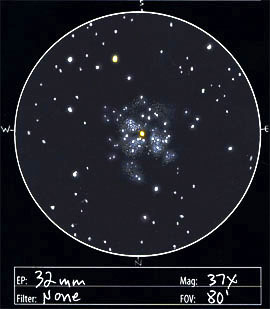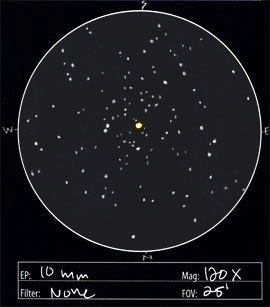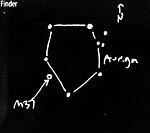

Observation Notes:
 Hoo-boy! This is a dense cluster. It had a roughly triangular shape, trisected by dark lanes focusing on a bright yellow-orange central star. It was very stunning to look at. I was really struggling with how to sketch it. Plotting star positions wasn’t giving the feel for granularity in the triangular area. In the end, I dashed in boundaries of the grainy regions, and then lightly shaded and stippled these. It looks like a little too blunt of an instrument, but it’s better than no indication at all. The south end of the view was punctuated by a bright yellow star. Going to a 120X view still showed some localized background granularity, but I didn’t indicate this in the close-up sketch.
Hoo-boy! This is a dense cluster. It had a roughly triangular shape, trisected by dark lanes focusing on a bright yellow-orange central star. It was very stunning to look at. I was really struggling with how to sketch it. Plotting star positions wasn’t giving the feel for granularity in the triangular area. In the end, I dashed in boundaries of the grainy regions, and then lightly shaded and stippled these. It looks like a little too blunt of an instrument, but it’s better than no indication at all. The south end of the view was punctuated by a bright yellow star. Going to a 120X view still showed some localized background granularity, but I didn’t indicate this in the close-up sketch.
Factoids:
M37 is the brightest and richest of the three Auriga Messier clusters. It contains 150 stars brighter than mag 12.5, with a possible total of 500 stars altogether. Its age is estimated at 300 million years, and contains at least a dozen red giants. Distance estimates range from 3600 to 4700 light years, with a diameter of 20 to 25 light years. M37 was discovered by Giovanni Batista Hodierna before 1654, and independently re-recorded by Charles Messier in 1764.
| Subject | M37 (NGC 2099) |
| Classification | Open Cluster |
| Position* | Auriga [RA: 05:52.4 / Dec: +32:33] |
| Size* | 24′ |
| Brightness* | 6.2 |
| Date/Time | February 3, 2005 – 9:30 PM (February 4, 2005 – 04:30 UT) |
| Observing Loc. | Flagstaff, AZ – Home |
| Instrument | Orion SVP 6LT Reflector (150 mm dia./1200 mm F/L) |
| Eyepieces/Mag. | 32 mm (37X), 10 mm (120X) |
| Conditions | Clear, 34°F |
| Seeing | 4/10 |
| Transparency | Mag 5.2 |
| Sources | SEDS |
*Based on published data.